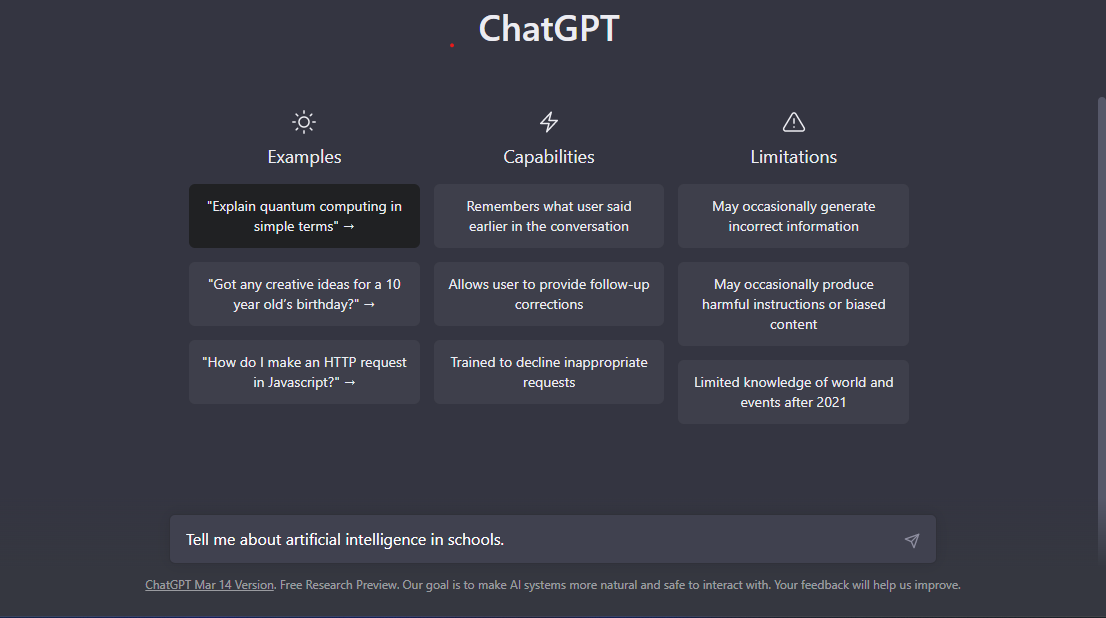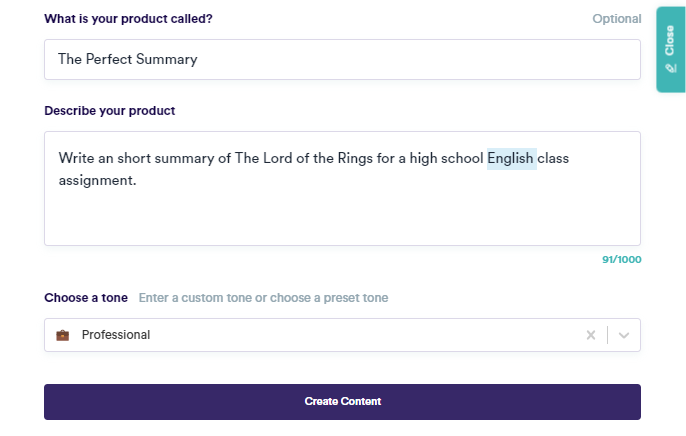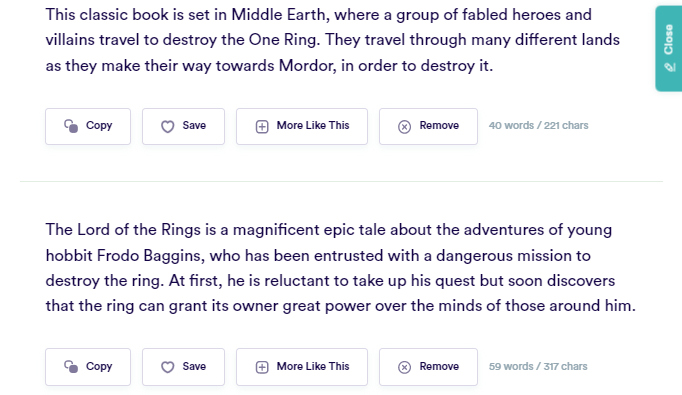What's Going on with AI at MSMHS?
Teachers and administrators offer thoughts on artificial intelligence and education.


Over the past few months, a boom in artificial intelligence (AI) products has started a debate around the role of AI in education. Amidst reports of AI-powered cheating, some schools—including MSMHS—have placed restrictions on AI use. Others have argued that schools need to embrace the technology, augmenting traditional methods of education. Smack dab in the center of this dispute is the somewhat clunkily named “ChatGPT,” an AI text generator capable of emulating basic human writing. Developed by the San Francisco-based technology company OpenAI, ChatGPT allows users to ‘talk’ with OpenAI’s text-creating algorithm, a large language model known as GPT-3. Users type a prompt into a text box, and ChatGPT uses data from a massive database of writing to string words together into coherent paragraphs.
In terms of academic writing, ChatGPT has excelled. Having already passed the three-part US Medical Licensing Exam, the final exam of the Wharton Business School Operations Management course, and four exams from the University of Minnesota Law School, the software’s writing ability has proven to be a point of contention for educators. Alarmed by reports of students using text generators for completing classwork, some school boards have gone on the offensive. The New York City and Seattle school districts have both instituted complete bans on ChatGPT for school-owned technology.
LEARN, the regional education service center that manages MSMHS and other magnet schools, has yet to propose an official plan for AI and education. As of March 28, however, LEARN has followed the course set by New York and Seattle, blocking ChatGPT on school devices during select hours. MSMHS principal Ms. Amatrudo is quick to point out that this isn’t the final decision. “I don't think our educational systems are doing enough to get ahead of AI as an educational tool vs. a threat to authentic learning,” she said, later adding that LEARN is using the ban as a “pause button,” giving administrators time to draft a comprehensive policy on AI.
“The students are always ahead of the teachers, and the adults figure it out later.”
Dr. Donlon, Associate Executive Director of LEARN, compared the apprehension surrounding AI in schools to education in the early period of the internet. As he explained, college assignments in the web’s early days often mandated that “no-internet” resources be sole sources of information, adding that, “Now, you couldn't think of creating an assignment that doesn’t involve the internet.” Both Dr. Donlon and Ms. Amatrudo noted how policy always lags behind the real-life issues it involves. Discussing this delay, Ms. Amatrudo said, “The students are always ahead of the teachers, and the adults figure it out later.”
This statement is particularly apt when considering the current methods for restriction. Ms. Amatrudo cites the “pause button” approach as the reason behind LEARN’s decision to block ChatGPT. In practice, this method is patchwork at best. While ChatGPT itself remains inaccessible during class time, a quick search for “AI writing generators” brings up seven AI programs on the first page of results—none of which are ChatGPT. Of the seven, one (Rytr) is blocked and four (Sassbook AI, Smodin, Writesonic, and Canva’s Magic Write) require a paid plan for extensive use. But two others (Copy.ai and Simplified), are easily available, requiring nothing more than a quickly created free account.

Ms. Mann, an English teacher at MSMHS, views blocking AI generators as a “fool’s errand.” “We’re not really blocking it, we’re just putting up a hurdle. Students who want to use it can use it on their phone, and send it to themselves.”

Echoing Ms. Amatrudo’s hope for thoughtful use of AI, Ms. Mann notes that artificial intelligence may benefit the learning experience. Discussing how students have to craft a well-thought prompt to get the AI to give a satisfactory answer, she says, “It’s not that dissimilar from learning how to do a good research query…The way you ask a question often dictates the quality of the material that is turned up in a search.” Continuing, she explains that AI has the potential to become a tool for self-directed learning, helping students “understand better how words operate, to understand the way words are used in the wild, to get feedback on your own writing…” However, she adds a caveat, “If I were designing a school, I would definitely have…the equivalent of calculator and non-calculator sections of the day.”
Mr. Jones, another MSMHS English teacher, agrees with this split-time approach. “A lot of what we teach in English class is taking the thought that’s in your head, the idea that’s in your head, and having it become a crystallized thing on the page.” But, he adds, these traditional methods can be augmented with AI-powered organization, helping with “synthesizing information from a lot of different places.” He continues “if you want to see how something looks on paper, or how a bunch of ideas look together for your own purposes, part of a larger research project, I think it can be very useful.”
Some educators have already had a chance to try out some of these new strategies, integrating artificial intelligence into classwork. As reported by NPR, Ethan Mollick, a professor of entrepreneurship and innovation at Wharton Business School, has incorporated ChatGPT into the syllabi of his classes. Aiming to prepare students for the rapidly changing work world, the revised curriculum seeks to give students experience with the “emerging skill” of AI use. This skill may be in-demand for future job candidates, and companies are gearing up to provide the tools they'll need. Already, Microsoft’s 365 suite of products (including Word, Excel, and Powerpoint) has begun implementing an AI feature known as Copilot, which Microsoft hopes will save time for busy employees by reducing time consumed by the drudgery of work” that revolves around “hours in writing, sourcing, and editing.” And with Google’s push to roll out more than twenty AI-driven products in 2023, the artificial intelligence arms race seems poised to dramatically alter the roles of tomorrow’s workforce.

Mollick argues that artificial intelligence is simply the next step in the world of thinking. “We taught people how to do math in a world with calculators.”
The beginnings of a more AI-inclusive curriculum have already started at MSMHS. Ms. Mann’s ECE English Composition classes have had several assignments that prompt students to dive into the ethics of AI. Ms. Mann views an understanding of the moral impact of AI use as essential for the modern work world. “What our students are going to need to be able to do…is collaborate with AI.”
However, focusing too much on artificial intelligence may hurt students’ learning. Mr. Jones worries that the overuse of AI could deprive students of the basic communication tools needed in all aspects of life. Referencing ChatGPT, he says, “It’s a tool to use, but what happens when you’re suddenly without that tool, are you going to have the skills you need?” Ms. Mann echoes this sentiment. “I also think that writing is a mechanism for learning, not only an expression of learning, but an actual mechanism for learning, and so I worry about that.” To ensure that students develop their skills, Mr. Jones and Ms. Mann have worked to create assignments that exceed the capabilities of text generators, often incorporating a personal aspect that AI can’t do on its own.
“It’s a tool to use, but what happens when you’re suddenly without that tool, are you going to have the skills you need?”
As Kalley Huang of The New York Times explains, “prompts like ‘write five pages about this or that,’” are a thing of the past. This supposed new age of education will see professors writing prompts that are “too clever for chatbots,” by “asking students to write about their own lives and current events.” Other teachers have circumvented AI altogether, returning to a more traditional method of essay writing—handwritten drafts. Antony Aumann, a professor of philosophy at Northern Michigan University, uses this approach, requiring drafts to be created by hand, with explanations of later revisions.
But this focus on preserving traditional types of writing may be part of a larger problem, one that AI is forcing us to confront. As Ms. Mann states, “I’m thinking people are conflating thinking and writing.” As a teacher of AP Art History, she suggests that, for social studies classes, “The content can be learned in different ways,” such as labeling diagrams and answering multiple choice questions. Writing might not even be necessary in some cases.
When discussing how artificial intelligence will impact writing ability in cases where it is needed, she notes, “If we’re assessing student writing, at the lower level, like in elementary school, I think we do need to assess kids' ability to write clear sentences.” But for high schoolers, AI may be able to act as a writing aid, “helping students refine writing and learn about sentence structure.”
Despite the convoluted nature of the artificial intelligence debate, both Ms. Mann and Mr. Jones say one thing is certain—things are moving very fast. As Ms. Mann said, “The breakneck pace of it, the developments of it, we don’t really know—even the people who are developing it don’t really know—where it’s going. They really can’t slow down, because other people will speed up.” Mr. Jones agreed, saying that the AI arms race seems to be “Innovation for the sake of innovation, without any kind of stopping and looking at the value of it.”
Finding a solution is a bit more complicated. Mr. Jones believes that understanding the various perspectives and issues involved is critical for finding an answer. “I think it's important to know what it is and how it works, understand its limitations, understand how to use it.” Ultimately, this issue likely won’t be going away anytime soon. The breakneck pace, combined with the lagging state of policy, brings one question to the forefront: what can teachers and students do now? For lack of an immediate answer, why not ask ChatGPT?





